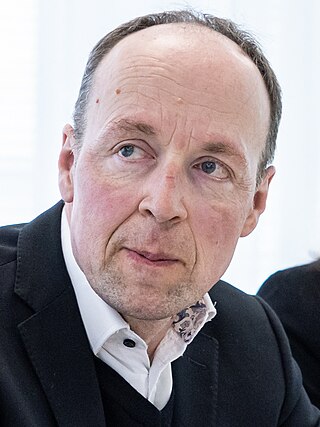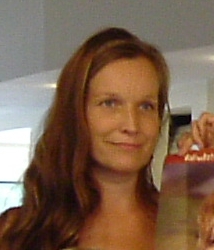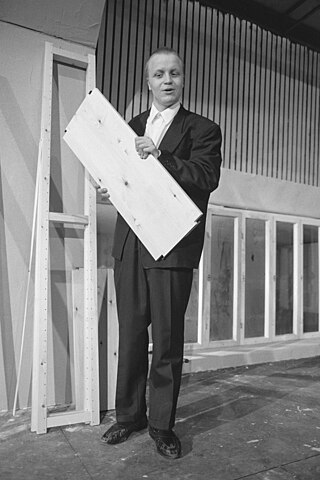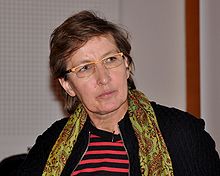
Yleisradio Oy, abbreviated as Yle, translated into English as the Finnish Broadcasting Company, is Finland's national public broadcasting company, founded in 1926. It is a joint-stock company, which is 99.98% owned by the Finnish state and employs around 3,200 people in Finland. Yle shares many of its organisational characteristics with its British counterpart, the BBC, on which it was largely modelled.

The Finns Party, formerly known as the True Finns, is a right-wing populist political party in Finland. It was founded in 1995 following the dissolution of the Finnish Rural Party.

The Unknown Soldier is a Finnish film from 1985 directed by Rauni Mollberg. It is based on the best selling Finnish novel by the same name written by Väinö Linna. It is the second film adaptation of Linna's novel, the first one being the 1955 film of the same title, directed by Edvin Laine. Third film adaptation of the same novel was released in 2017, directed by Aku Louhimies.

Tapani Rinne is a Finnish musician, composer, record producer and sound designer, who is known for his experimental and innovative style with the clarinet and saxophone. It has earned him a reputation as one of the most respected and unique Nordic instrumentalists.

Pirkko Helena Saisio is a Finnish author, actress and director. She has also written under the pen names Jukka Larsson and Eva Wein. Saisio has a broad literary output, dealing with many kinds of texts from film screenplays all the way to librettos for the ballet. Her novel Betoniyö (1981) was adapted into a feature film Concrete Night in 2013 by Pirjo Honkasalo.

Jussi Kristian Halla-aho is a Finnish politician, currently serving as the Speaker of the Parliament of Finland since 2023. Halla-aho has served as a member of the Parliament of Finland from 2011 to 2014 and again since 2019, and as the leader of the Finns Party from 10 June 2017 to 14 August 2021. Previously, between 2014 and 2019, he was a member of the European Parliament, where he was part of the Identity and Democracy group.

The 3 Rooms of Melancholia is a 2004 Finnish documentary film written, directed and co-produced by Pirjo Honkasalo. The film documents the devastation and ruin brought on by the Second Chechen War, more specifically the toll that the war had taken on the children of Chechnya and Russia.

Flame Top is a 1980 Finnish drama film directed by Pirjo Honkasalo and Pekka Lehto. It was entered into the 1981 Cannes Film Festival. The film depicts the life of the writer Algot Untola. The film was selected as the Finnish entry for the Best Foreign Language Film at the 53rd Academy Awards, but was not accepted as a nominee.
Pekka Lehto is a Finnish film director. He has directed fifteen films since 1976. He co-directed Flame Top with Pirjo Honkasalo and the film was entered into the 1981 Cannes Film Festival. He also won the Jussi Award for Best Director for the film.

Johanna Vuoksenmaa is a Finnish television and film director and screenwriter who has also worked as a photographer, installation artist and a teacher. Her films have been shown at numerous film festivals around the world and she has won many Finnish film and television awards for directing and screenwriting. As a director and screenwriter, Vuoksenmaa prefers the comedy genre because to her comedy means relief, forgiveness and defense. She does not use casting agencies but prefers to cast actors to her films herself, since she thinks that it creates a level of trust between the actor and the director.

James Hirvisaari is a Finnish politician. He was elected to the Finnish Parliament in the 2011 general election held on 17 April on the electoral list of the Finns Party, but since 2013 he has represented Change 2011.

Concrete Night is a 2013 drama film directed by Finnish filmmaker Pirjo Honkasalo. The film is based on a novel with the same name, written by Pirkko Saisio and published in 1981, though adapted to modern times. The story has also been adapted to theatre and has been played in Finland and in Venezuela. Concrete Night had its world premiere at Toronto International Film Festival in the Masters Series in September 2013. The film was shot in the Helsinki area in Finland in September and October 2012. Produced by Misha Jaari and Mark Lwoff from production company Bufo and co-produced by Swedish Plattform Produktion and Danish Magic Hour Film, the film was funded by Finnish Film Foundation, Yle, Nordisk Film & TV Fond, Swedish Film Institute, Danish Film Institute and Danske Radio. The film was nominated for the 2014 Nordic Council Film Prize. It was selected as the Finnish entry for the Best Foreign Language Film at the 87th Academy Awards, but was not nominated.

Iina Kuustonen is a Finnish actress.

Jani Kristian Volanen is a Finnish actor, writer and director. Born in Helsinki, he has appeared in more than fifty TV and movie productions and thirty professional theater productions since 1986. Volanen has also created and directed many comedy shows for Finnish television. Volanen often plays characters with personality disorders. He is a member of the comedy group Julmahuvi.
Eero Milonoff is a Finnish actor. He won a Guldbagge Award for his role in the 2018 film Border, and he has been a nominee at the Jussi Awards for his roles in the films Ganes (2007) and The Happiest Day in the Life of Olli Mäki (2016).
Elsa Helena Saisio is a Finnish actress. She graduated from the Helsinki Theatre Academy in 2003.

Presidential elections were held in Finland on 28 January 2024, with a second round held on 11 February. Voters elected a president of the Republic for a six-year term. Incumbent president Sauli Niinistö was term-limited and ineligible to run for re-election, having served the maximum two terms, ensuring that the president elected would be the country's thirteenth.
Alli Haapasalo is a Finnish director and writer.
Laura Åkerlund is a Finnish opera stage director and pianist. In 2019, she was a finalist for the position of Directrice Générale at the Opéra de Lyon, and in 2021, she was a finalist for the same position at the Opéra National de Bordeaux.














